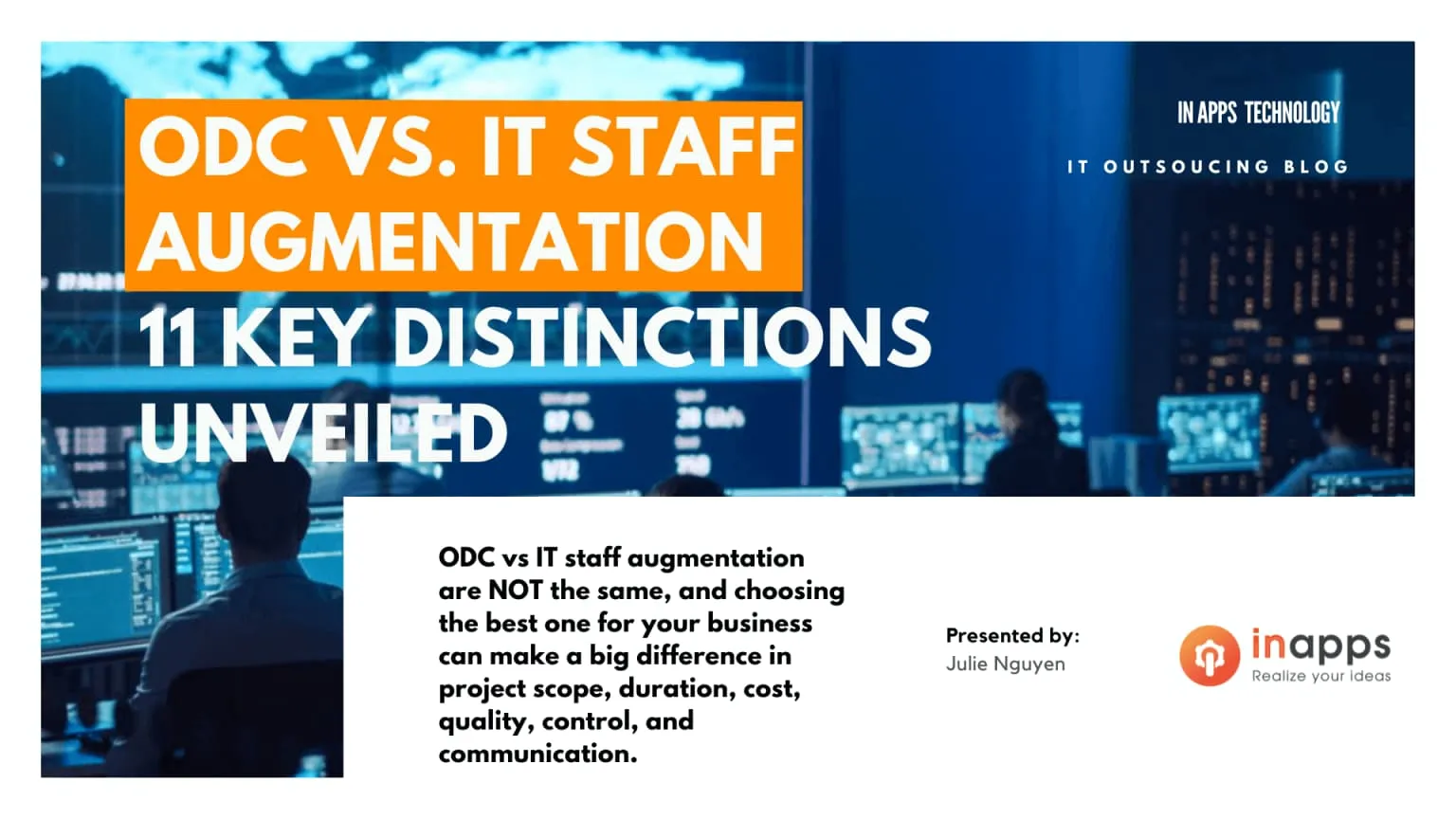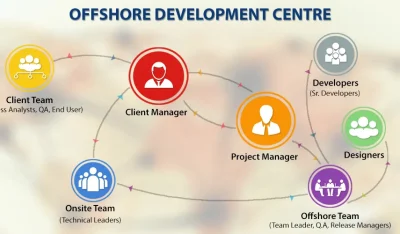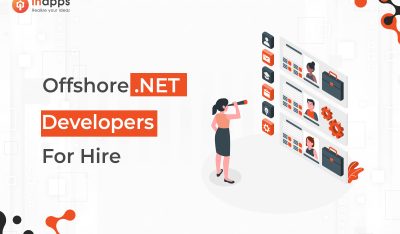- Home
- >
- Offshore News
- >
- Diving into ODC vs IT Staff Augmentation: 11 Key Distinctions Unveiled
Offshore Development Center vs IT Staff Augmentation: Which one do you refer to?
In today’s rapidly changing world of software development, finding skilled professionals has become a significant challenge for companies worldwide. According to Mordor Intelligence, the global IT staffing market size is expected to grow from $ 114.75 billion in 2023 to $ 137.34 billion by 2028, with a steady yearly growth rate of 3.66%.
Business leaders, unsurprisingly, find it tough to locate and hire the right talent, as up to 88% of them face this challenge. And to cope with this competitive landscape and keep their business afloat, many companies are turning to remote hiring models: ODC vs IT staff augmentation.
These data indicate a high demand for ODC vs IT staff augmentation across various end-user industries such as telecom, education, BFSI, healthcare, manufacturing, and retail. However, both approaches are NOT the same, and choosing the best one for your business can make a big difference in project scope, duration, cost, quality, control, and communication.
So, how can you make the right choice for your business? Don’t worry if you’re still considering it. Our team will compare IT staff augmentation vs ODC side by side and help you decide which one to choose for your software development needs. Notably, these differences are carefully considered based on expert opinions from software industry leaders like Inapps.
Sounds good 😉? Let’s jump in!
A Quick Comparison Table of ODC vs IT Staff Augmentation
Here is a quick overview table between Offshore Development Center vs IT staff augmentation v based on 11 essential aspects to consider. This way, it will be easier to check when needed. Besides, if you feel like one suits your project requirements, simply scroll down to learn more about its detailed definition, pros, cons, and hiring fees!
| Criteria | Offshore Development Center (ODC) | IT Staff Augmentation |
| Definition |
|
|
| Purpose |
|
|
| Project Scope |
|
|
| Commitment |
|
|
| Cost |
|
|
| Quality |
|
|
| Control |
|
|
| Flexibility |
|
|
| Communication |
|
|
| Team integration |
|
|
| Scalability |
|
|
You might like: 5 reasons why remote software development is the best way for “saving” start-ups
What is an Offshore Development Center? (aka Offshore Software Development Center)
An Offshore Development Center (ODC) is one of the most popular outsourcing models, where you hire an external company to create and manage a dedicated team of software developers and IT professionals for your project.
This external team is located in another country, often with lower labor costs and tax benefits, and acts as a branch or extension of your main company. And ODC is a good fit for companies seeking cost-effective solutions and long-term collaboration and partnership.

The Offshore Development Center is located in another country, often with lower labor costs and tax benefits.
ODC offers various services like software development, website design, SEO, IT support, testing, and more. It includes different specialists you may need, such as developers, QA engineers, project managers, product managers, designers, writers, UX/UI specialists, marketing experts, and others. Also, they handle additional tasks like taxing, bookkeeping, and HR management.
More than expected, you can save up to 40% with ODC on your software development expense, especially in infrastructure costs. Additionally, you gain access to a broader talent pool and expertise that may not be available or affordable locally.
Related: 5 Key Benefits of Choosing an Offshore Development Center
When should you use Offshore Development Center?
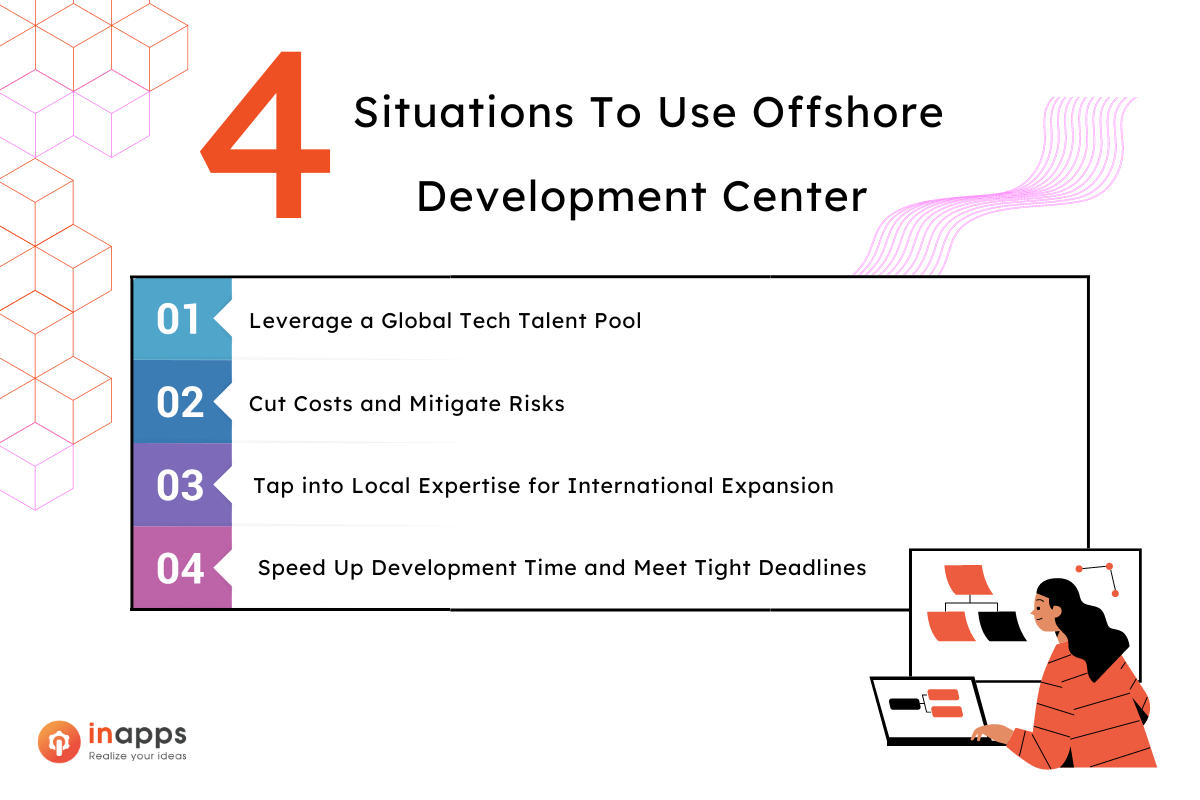
1. Leverage a global tech talent pool to scale up your IT operations
If your company is experiencing rapid growth and you need to expand your team with more developers and engineers, consider setting up an ODC in countries like Vietnam, India, or Ukraine. These locations have abundant and skilled IT workforces, allowing you to quickly access a pool of talented professionals to meet your project demands.
2. Cut costs and mitigate risks with offshore development
Secondly, if your company aims to save on recruitment, taxes, insurance, equipment, and other operational expenses, then establishing an ODC in a country with a lower cost of living and labor can be a smart move. This offshore location offers cost advantages, reducing overhead costs associated with hiring and maintaining a team in your home country.
3. Tap into local expertise for international expansion
Planning to launch your product or service in a new region or country? Then setting up an ODC in that specific location can be highly advantageous. The IT offshore team can provide valuable market insights, cultural understanding, and business practices tailored to the target market, facilitating a smoother expansion process.
4. Speed up development time and meet tight deadlines
For urgent IT projects with tight deadlines, consider establishing an ODC in a country with a significant time difference from your country. Working with the offshore team around the clock allows you to speed up the development process and ensure timely project delivery, even when facing time constraints.
Pros of Offshore Development Center
ODCs can offer many benefits for businesses that want to access global talent pools, reduce operational costs, and improve the efficiency and quality of software development. Some of the pros of ODCs are:
1. Access a diverse and skilled talent network
When you have a team with diverse backgrounds and experiences, they tend to think differently and generate unique ideas. This diversity can enrich your strategy and leverage cultural differences and varying perspectives that an offshore development team can offer to your project. Moreover, hiring a developer in the US typically takes around 35 days, while finding a developer in countries like Vietnam or Ukraine can take half that time on average.
2. Reduce development expenses
Cost savings are the main advantage of offshoring. In the IT industry, salaries for skilled workers are high, especially in developed countries. This can be a significant financial burden for companies trying to hire digital experts, as labor costs are often the biggest obstacle to expanding their business.
However, with offshoring, companies can hire dedicated developers willing to work hard and meet deadlines, all at a lower cost of up to 40%. In essence, they can pay less but get more value, allowing them to invest their savings in other aspects of their business.
For example, US and Western European developers may charge $60 to $200 per hour, while Central Europe may charge around $50 per hour. In countries like Vietnam, the hourly rates can be as low as $20 to $50. Countries like India and China also offer more affordable rates than Western countries.

In countries like Vietnam, the ODC’s hourly rates can be as low as $20 to $50.
3. Concentrate on your core business
Managing an in-house IT department can be costly, especially if your company’s primary focus is on something other than information technology. Outsourcing these complex IT tasks to an ODC can eliminate numerous challenges and enable you to focus more on core business activities. As a result, you can dedicate time and effort to what truly matters for your business.
4. Access to established infrastructure
ODCs significantly shorten development time, leading to increased efficiency. With access to a broader pool of experts and an established infrastructure, especially when you have the right partner, processes become faster and more efficient.
Furthermore, ODCs offer an excellent solution for developers aiming to create top-notch products for their local market. These centers are often situated in regions with well-developed technology infrastructure, ensuring the delivery of high-quality products at a competitive price.
5. Increased efficiency and reliability
An Offshore Development Center can help you deliver your project on time and within budget. You can expect greater efficiency and productivity with an established infrastructure, a dedicated team, and a streamlined workflow. Additionally, by leveraging the time zone difference, your businesses can benefit from faster turnaround and 24/7 support, ensuring a smooth and timely development process.
Cons of Offshore Development Center
While offshore development centers can offer many benefits for software development projects, they also come with some drawbacks and challenges you should consider before setting up one. Here’re some drawbacks of ODCs:
1. Communication barriers
Effective communication is vital for the success of any offshore project. However, when working with an ODC in a different country or region, certain challenges in communication may arise, including:
- Language differences
- Cultural nuances
- Time zone gaps
- Technical issues
- etc.
These obstacles can result in misunderstandings, delays, conflicts, or errors during the software development process.
For instance, easy accessibility to your offshore team is really essential. Yet, time differences can make this challenging. The key is to find a suitable time that works for all parties involved – not too early or too late. When it’s 9 am in certain parts of the US, it’s 3 pm in Poland, making it a favorable time to connect.
2. Organizational structure challenges
Companies have varying structures, and what may work in your country might not be suitable when establishing an Offshore Development Center (ODC) elsewhere. This difference can significantly impact all aspects of the ODC setup
3. Security risks
One critical concern for many companies when considering offshore development center services is how to ensure information security despite the geographical distance. The risk of sensitive data leakage is a genuine worry.
Moreover, even if you keep all your resources in one location, it doesn’t guarantee protection from all security risks. The key lies in conducting a security risk assessment in advance and taking appropriate measures to address the specific risks faced by your ODC.
Last, signing nondisclosure agreements and ODC security protocols is necessary before finalizing the partnership. By doing so, your organization’s data remains safeguarded from security breaches and privacy violations.
4. Legal challenges
Offshore software development is a multifaceted process that requires a clear understanding of the associated legal risks. Similar to establishing a department in another country, you need to carefully assess the legal environment and determine if the country’s business rules align with your business needs. If you prefer to avoid dealing with these complexities, you can engage the vendor to handle the tasks on your behalf.
What is IT Staff Augmentation?
IT Staff Augmentation is another way of hiring outside IT experts for short-term or project-based needs when a business lacks enough in-house know-how. Unlike ODC, these external workers become part of the company’s team and work directly with its managers. This approach allows corporations to quickly grow their workforce, access a larger pool of talented individuals, and adjust team size as needed.
As mentioned earlier, staff augmentation has become more popular in the IT industry due to a significant lack of specialized tech talent. Research conducted by ManpowerGroup shows that 77% of companies worldwide reported skill shortages in 2023.
In this situation, the demand for IT professionals, such as software development, quality assurance, programmers, cybersecurity, technical support, and more, is exceptionally high. And by adopting the staff augmentation model, organizations can utilize their existing resources and hire skilled IT talent through outsourced contract workers to meet their business needs effectively.

IT Staff Augmentation is about hiring outside IT experts for short-term or project-based needs to fill skill gaps.
Besides, the duration of the augmentation varies based on the project’s demands, ranging from a few weeks to several months or longer. Once the specific project or temporary need is fulfilled, the augmented staff may either no longer be required or can be assigned to other tasks as necessary.
Overall, IT Staff Augmentation is gaining popularity among businesses, particularly startups, due to its flexibility, efficiency, and the high-quality talent it provides access to. Still, to ensure successful collaboration between the in-house and external teams, it requires careful planning, communication, and management.
When should you use IT Staff Augmentation?
Knowing when to hire IT staff augmentation is also essential for your business. Here are 5 situations where staff augmentation can be your ideal solution.
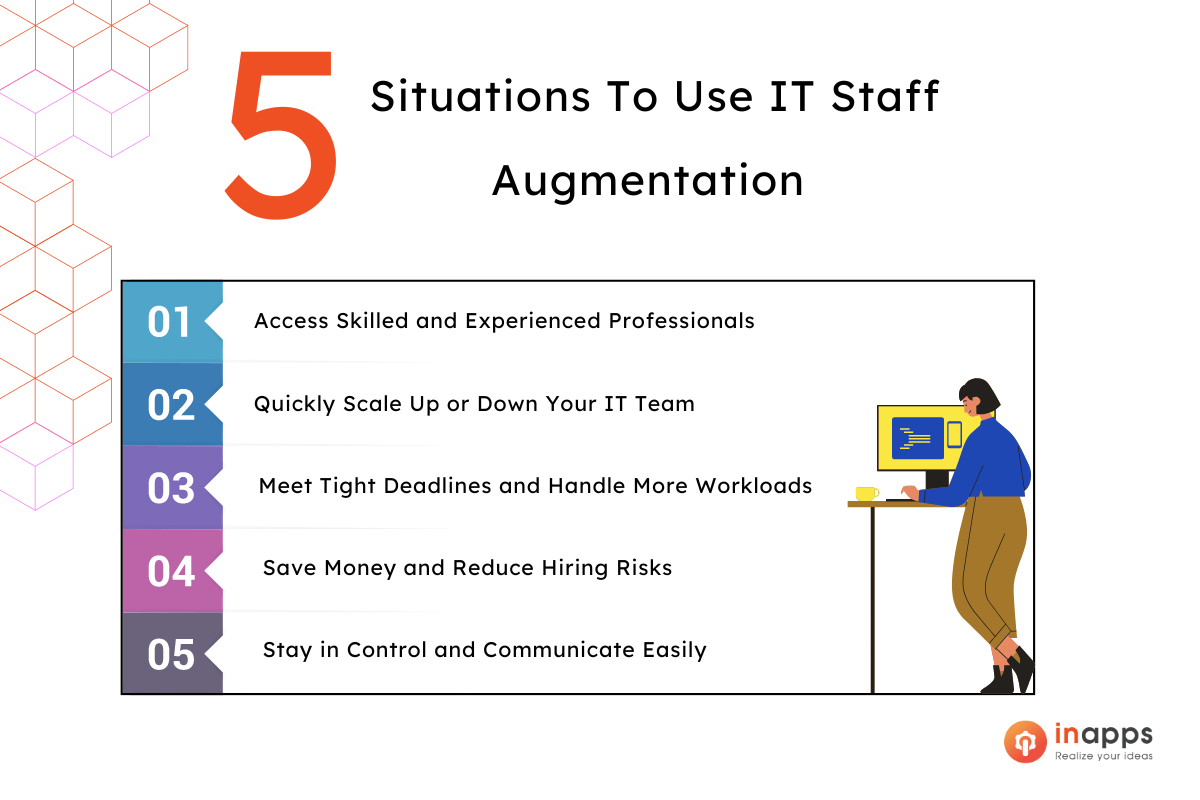
1. Access skilled and experienced professionals
When you need to develop a mobile app using Flutter, but your in-house developers only know Java, IT Staff Augmentation comes to the rescue. By hiring a Flutter developer through this model, you can quickly add the required expertise to your team without committing to a permanent hire. This ensures you have the right skills to deliver high-quality results for your specific project, even if it falls outside your team’s current skill set.
Read more: Flutter vs React Native vs Xamarin: What’s best in 2023?
2. Quickly scale up or down your IT team
Let’s say you have a seasonal project that demands more developers for a few months, but you don’t want to maintain a larger workforce permanently. IT Staff Augmentation provides the flexibility to scale your team according to project requirements quickly. You can hire additional developers for the required period and release them once the project is complete. This allows you to maintain operational efficiency and cost-effectiveness without unnecessary long-term commitments.
3. Meet tight deadlines and handle increased workloads
Next, suppose you have an urgent IT project that must be delivered within a short timeframe. IT Staff Augmentation allows you to bring in extra developers to speed up the development process and meet tight deadlines. These temporary team members can contribute their skills and experience to ensure the successful and timely completion of the project without overburdening your existing staff.

Any business must know when to hire Offshore Development Center vs IT staff augmentation.
4. Save money and reduce hiring risks
Bringing in and integrating new employees can be both costly and time-consuming. But with IT Staff Augmentation, you save on recruitment costs, taxes, insurance, equipment, and other overhead expenses. More so, you reduce the risk associated with permanent hires, as you can evaluate the capabilities of the augmented team before making any long-term commitments.
5. Stay in control and communicate easily with external developers
In some cases, you may prefer to manage the project yourself and maintain direct communication with the developers. IT Staff Augmentation allows you to integrate external developers seamlessly into your workflow, ensuring regular updates and feedback. By doing so, you can ensure that the project stays aligned with your vision and objectives while having the flexibility to scale the team as needed.
Pros of IT Staff Augmentation
IT staff augmentation offers a flexible and cost-effective solution for hiring qualified professionals for specific projects or tasks without the burden of recruiting, training, or retaining full-time employees. However, the advantages don’t stop there:
1. Quick access to top-notch, specialized talent
With IT staff augmentation, you can say goodbye to months of training for less-skilled in-house employees. Augmented staff are already experienced professionals in their field, so they can hit the ground running. They may need minimal training to adapt to your company culture, but they’re prepared to bring significant value to your company.
Interestingly, hiring in-house teams may sometimes hinder you from onboarding highly talented professionals. In contrast, staff augmentation opens access to a vast pool of experienced experts. You can find domain-specific talents who can deliver excellent results tailored to your specific needs.
2. Enhance project visibility
When you hire IT augmented staff, you have a clear vision of your requirements since you’re assembling a team for a specific project. Staff augmentation ensures enhanced productivity and motivation, as the augmentation team dedicates all their time and effort to this project. This focused approach increases efficiency and a determined purpose, which is crucial for successfully scaling any high-powered project.
With a specialized, elite, and carefully selected team, there is little room for ambiguity regarding objectives, poor planning, time mismanagement, or unrealistic expectations. Transparent and well-defined project goals facilitate smooth progress and timely achievement of milestones within the appropriate time frame.
3. Cost savings through lower salaries and faster recruitment
At times, a need arises to hire someone for a brief period, possibly weeks or months. In such situations, opting for temporary staff through staff augmentation proves to be more cost-efficient than hiring full-time employees. You can acquire quality talent while spending fewer dollars on recruitment, overheads, and employee expenses.
Studies reveal that recruiting an expert engineer as in-house staff could take 42 days, resulting in a potential productivity loss of about $41,049. Additionally, hiring a full-time programmer incurs recruitment costs ranging from $11,000 to $20,000, not to mention an average of 29 weeks of training for new hires to reach optimum productivity.
By choosing augmented staff short-term, you save considerable human resource expenses for recruiting, interviewing, and training staff. Moreover, these professionals already possess expertise in your required domain, reducing the need for extensive training.

Offshore Development Center vs IT staff augmentation can be cost-effective solutions for your business.
4. Improved strategic business decision-making
Another advantage of staff augmentation is that you have complete control over the augmented staff, similar to an in-house team, but even better because you get to handpick the specific skills you need. The project manager directly oversees the tasks of the augmented staff and ensures their seamless integration into the team.
You no longer need to worry about assigning tasks to permanent staff or constantly providing training to upgrade their skills, mainly when their commitment to your company may be limited. With staff augmentation, you have complete authority over their operations, allowing you to monitor and adjust result-oriented capabilities as required.
5. Gain a fresh new perspective
Finally, adding new members to your team presents an excellent opportunity to gain fresh perspectives. While your research and experience have guided you towards certain tech solutions and goals, your temporary IT experts could bring valuable insights and a new outlook on what works best for your company.
Think of IT staff augmentation as a chance to engage with various temporary consultants who will familiarize themselves with your company’s technical infrastructure. They will use their knowledge and background to identify the best solutions and suggest efficient processes to achieve your goals.
Cons of IT Staff Augmentation
As you can see, the list above highlights the strengths of staff augmentation, which are undoubtedly beneficial. However, it’s important to note that these advantages may not be suitable for every company or work scenario. Problems can arise if staff augmentation is not managed appropriately, especially when short-term work transitions into long-term projects. Below are some of its cons:
1. Unsuitable for large or long-term projects
IT staff augmentation may not be the most suitable solution for large, long-term projects that necessitate ongoing support and development. While this approach can initially save your organization money, if the project extends beyond your initial expectations, it can lead to increased labor costs. You’ll be paying for highly-skilled specialists, which could increase overall expenses.
2. Require training
Even if you hire the right people for the project, there may still be a need to provide training not just on the technical capabilities but also on your company’s processes, tools, and work culture. Besides, while managing out-staffed employees might be relatively more accessible, you still need the capacity to handle the increased staff.

Both offshore development center vs IT staff augmentation have their strengths and are valuable in different situations.
3. No internal knowledge
Certain projects demand prior knowledge about the project or the company, and with staff augmentation, only existing employees possess this knowledge. Anyone brought in from outside the team must access the necessary information. That’s why it’s crucial to share all the relevant information with the staff augmentation provider, as they will transfer this knowledge to the external team members.
4. Lack of proper project management
One of the most common IT staff augmentation problems is the potential lack of contract management. This occurs more frequently than expected and is related to the contractual obligations of your developer’s tasks and their expected duration within your team. Hence, it is essential to clearly outline the developer’s responsibilities and their estimated tenure in the contract. If you are still determining the duration of their hiring, consider including a clause stating that both parties can terminate the agreement with a standard 15-day notice. This simple addition can save you from months of legal complications.
Offshore Development Center vs IT Staff Augmentation: Which One is Better?
Regarding choosing an offshore development center vs IT staff augmentation, the question is not so much “If” but “When.” Both options have their strengths and are valuable in different situations. The decision ultimately depends on your project needs, budget, and long-term goals. Allow us to elaborate on the factors to consider when making this choice:
Offshore Development Center (ODC):
- Best for long-term, complex projects that require dedicated teams.
- Provide access to a network of skilled professionals in a specific location.
- Offer a more integrated and focused approach with a dedicated team working solely focused on your project.
- Suitable for companies looking to establish a long-term partnership and have extensive software development needs.
IT Staff Augmentation:
- Suitable for companies seeking short-term or specialized projects that require specific skills.
- Allow you to hire professionals for a limited duration without the overhead costs of permanent employees.
- Provide flexibility and scalability, as you can quickly add or remove team members.
And that’s all about considering between ODC and IT staff augmentation. If your business needs reliable offshore software development company services and exceptional app solutions tailored to your specific requirements, look no further than InApps. We are a trusted partner, boasting a skilled team of 100+ experienced developers, designers, and project managers who consistently deliver high-quality products and solutions across different industries. Don’t hesitate any longer – explore InApps offerings and let us know how we can support your projects. Thank you for reading!
Let’s create the next big thing together!
Coming together is a beginning. Keeping together is progress. Working together is success.




